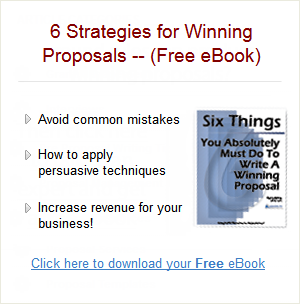The Section That Dictates Your Proposal's Fate
How important is an executive summary? Simply put, it can be central to success. Consider this: The executive summary may be the only part of your proposal read by senior management and the only part read by all of the evaluators. Yet many firms don’t understand the significance of this key section. A poorly written summary immediately erects a barrier to winning; an exciting, captivating summary sets the stage for victory.
While the executive sum-mary is usually the shortest part of a proposal, it’s also the portion that your potential customer reads first. Thus, this section requires the most skillful writing. Indeed, some evaluators are so offended by a specific executive summary one that is confusing, difficult to understand or merely a thinly disguised sales brochure that they fail to evaluate the rest of the proposal with an open mind.
Most books and workshops about proposal writing cover this increasingly important topic. In this article, I’ll deal with the basics by answering a series of questions.
What is an Executive Summary?
The executive summary provides your clients with a clear and concise rationale for choosing your solution. After reading the executive summary, clients should understand your solution and the unique benefits it offers. Clients must understand why they should buy from you even before reading the rest of the proposal.
In fact, clients often use the executive summary as a substitute for the proposal. You should assume that the executive summary is the only section of the proposal a client will read. By including highlevel themes that cover all of your main points, you improve the chances that your message will reach all evaluators and decisionmakers.
What does it contain?
“The executive summary is a job for skilled writers,” says Don Helgeson, an engineer who’s spent many years crafting large proposals and author of a solid book on proposal writing. Here’s how Helgeson describes the executive summary:
- It should be brief, terse and designed to hold the reader’s attention.
- It is a sales pitch based on the presentation of provable facts.
- It should focus on the salient features of your proposal and of your company.
- It provides the reader with an introduction to your company; the highlights of your proposal (the major decisions, innovative features and benefits to the customer); themes (what distinguishes your proposal from the rest); and the organization of your proposal.
Sue Baugh and Robert Hamper in their Handbook for Writing Proposals provide an outline of the executive sum-mary, a list of common errors and a checklist.
They recommend positioning the executive summary by asking yourself a series of questions: “By the time you are ready to write the executive summary, you should know the client and the client’s problems so well that you can put yourself in the decision-maker’s shoes and ask, ‘What would I want to know from the executive summary? What would grab my attention and keep me reading?’ ”
How do you know if your executive summary is solid?
There are a number of common errors that people make in dealing with this topic. Here are some simple rules:
- Don’t prepare the executive summary last.
- Don’t begin with boilerplate, do a “search and replace,” tweak it a little and give it to someone to print.
- Don’t begin and end with clichés like: “We are pleased to submit our proposal for …” and “Thank you for the opportunity …” and “Please do not hesitate to call …”
- Don’t make multiple claims of greatness without proof.
- Don’t attempt to show your understanding of the requirements by copying paragraphs from the RFP. This only demonstrates that you know how to copy.
When is it written?
Because the executive summary contains the core message of your solution, it should form the foundation of your entire proposal. Your proposal should expand upon the executive summary; the executive summary should not say anything that is not amplified in the proposal.
The sales team should draft the executive summary as early as possible, certainly no later than the proposal kickoff meeting. Distribute your latest version of the executive summary at the proposal kickoff meeting.
Why use a draft executive summary?
In discussing this topic with Larry Newman of Shipley Associates, he reminded me that many firms prepare the executive summary first, as soon as they have the capture strategy.
“A draft executive summary is one of the best vehicles for transferring intelligence from the sales team to the proposal team,” said Newman. “The sales team knows the client best and is in the best position to draft the executive summary because they know the client’s vision, needs and hot buttons. The sales team should have a sales or capture strategy and have outlined a solution.”
There are other benefits of having a draft executive summary, too. With minor modifications, you can adapt the document to make client presentations, brief your management, brief business partners, refine your strategy and brief your proposal team.
Executive summaries also promote effective internal communication. Some organizations use the executive summary as a preliminary tool that conveys information about the client and competitors, and to match their in-house strategy and solutions to client needs.
Other organizations write an actual executive summary mockup for the development team, upper management and negotiators.
Top management should review and endorse the executive summary and communicate their endorsement throughout the organization. Key proposal participants should feel confident that the executive summary expresses a comprehensive strategy that has support throughout the organization.
The final word on this goes to Newman: “Amazingly, proposals are still submitted without an executive summary. Yet pages devoted to the executive summary are the most important in your proposal.”

